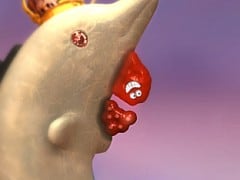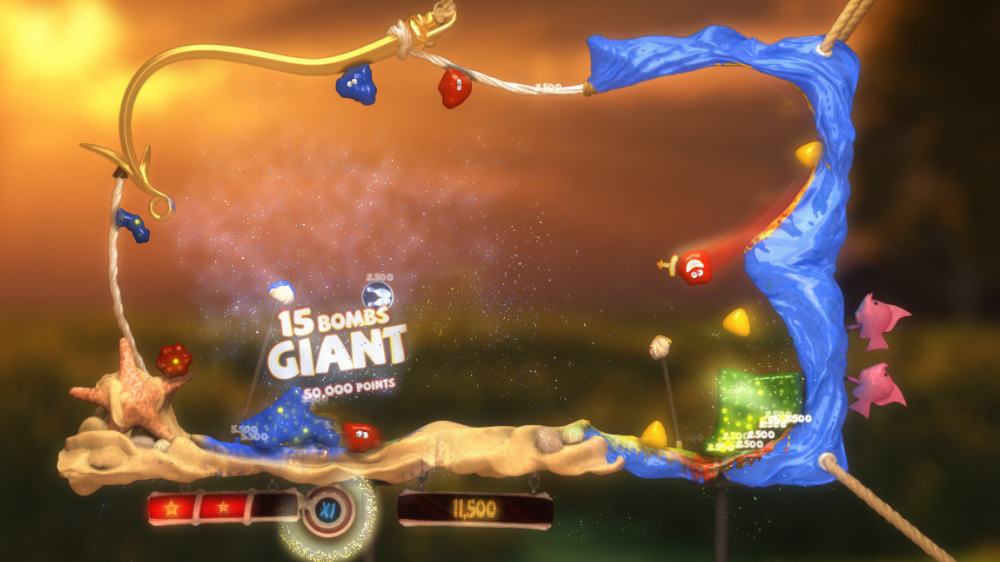You can trust VideoGamer. Our team of gaming experts spend hours testing and reviewing the latest games, to ensure you're reading the most comprehensive guide possible. Rest assured, all imagery and advice is unique and original. Check out how we test and review games here
In games, a protagonist’s ability to win usually comes from staying alive to accomplish goals. For splatters, it’s different: their victory is linked to death. These gelatin creatures are funny, silently acknowledging you from the television screen with dopey grins on their faces, knowing their end is just a few controller inputs away. They’re more than ok with this. In fact dying gives them purpose.
Dying with a certain pizzazz, that is. As stars of a combo-centric puzzle game in an obstacle course world, the eponymous splatters are ready to go out with a bang. And they’re trusting you to guide them towards whatever great blobby beyond there may be while pulling off as many crazy tricks as possible.
Every splatter wants their day in the sun and each level is allotted a certain amount of them, as well as a set number of globular bombs. Upon a splatter’s death-they face their end when handled too roughly-they explode in a viscous goo, detonating any nearby explosives on touch. This is every splatter’s dying wish and your ultimate goal. However, it’s during the penultimate stage that you get to choose exactly how you’ll use each splatter to most effectively and stylishly get rid of all the bombs.
Luckily for splatters on the chopping block, the simple DIY-ish level constructions have been primed for maximum trickery. Curved walls allow your splatters to pick up speed or sliding in arcs and going through loops. Spikes rupture the buggers on touch, which is handy for blowing any bombs underneath. Level design can accommodate a number of outcomes, based both on your inputs and a given stage layout. Think of these free-for-alls as a sort of gooey version of Dirt 3’s gymkhana courses, just with a goofy fatalist design.
Splatters themselves seem to have evolved a skillset built for dying well. In addition to hopping around terrain, you can charge them up to slam into a wall, subsequently changing trajectory after impact. You can also send them on full speed collisions or shift time, albeit only in slight jilts back and forth, as if Braid had a half-second limit per chronological adjustment that effected the directional yaw of its physics.
There’s strategy to all of this, of course. Loop-de-loops and curved surfaces will lend momentum to a splatter’s movement and can be used to move clusters of bombs that are stuck in its path when used with shifts, for instance.
Slamming a splatter into a bomb-adjacent wall and sending your remaining trajectory in the opposite direction is a good way to coat a wide cluster of targets in liquid remains. A personal favorite is using gained momentum while shifting – as your splatter turns into a final liquid-like state, you can “swing” its falling path back and forth with a pendulum effect by shifting in either direction.
Once you have these basics down, the real challenge comes in the form of combos and more skillful execution. These are what you’d expect – try to chain as many stunt combos together and pull off expert-level moves with very stringent limits and requirements. They’re arguably even more fun as well as more taxing. But when you hit a million-plus points with a high-combo chain, it feels great.
SpikySnail’s Niv Fisher worked on physics-based sims in the medical field before trying game design, and it’s the impressive physics that really make The Splatters as fun as it is. And just because the titular creatures aren’t around to enjoy the fruits of their demise (for long, anyway) doesn’t mean you shouldn’t.
Version Tested: Xbox 360







